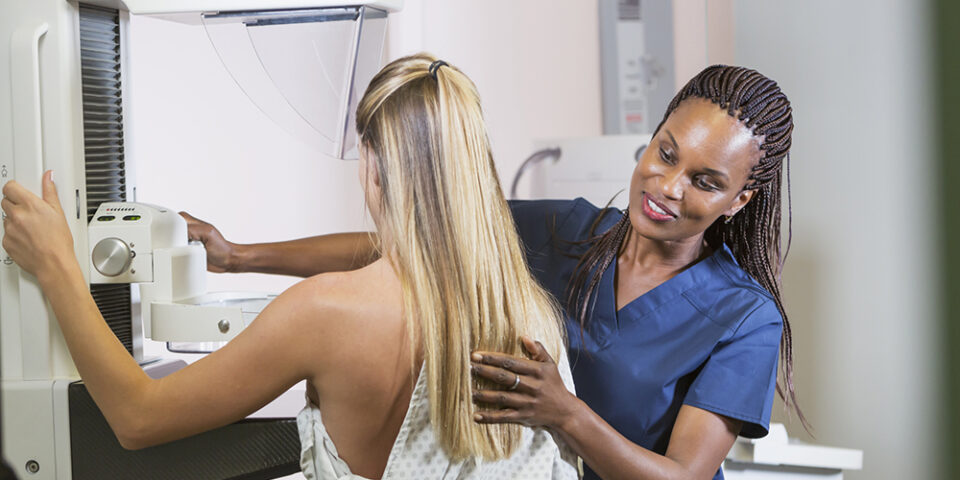First mammogram? Here’s what to know
You know it’s time for a mammogram, but you have questions … and maybe a little anxiety about the process. How do I prepare for the screening? What if I have implants? What’s a 3D mammogram and do I need that? Radiologist Douglas Bull, MD, explained what you need to know before you get your first mammogram.
Why are mammograms needed?
One woman in eight is diagnosed with breast cancer every year. Breast cancer is the most common cancer after skin cancer and the second most common cause of cancer death after lung cancer. The good news is, screening mammograms can catch breast cancer early when it’s easier to treat.
The American College of Radiology, the American Society of Breast Surgery and the American Cancer Society recommend yearly screening mammograms beginning at age 40 for women with normal risk.
How can I make sure the mammogram screening goes well?
Dr. Bull offered some tips on how to best prepare for your first mammogram:
- Schedule the appointment for a week (or two) after your period. “Try and schedule your mammogram around day seven through day 16 of your cycle,” Dr. Bull said. “That is when hormonal influences on breast tissue are least prominent. Because the effect on the glandular tissue is less at that time, there’s a slightly lower chance of having a false positive or calling a patient back for something that just turns out to be a physiologic condition that can happen through the cycle. It’s also when your breasts are less likely to be more tender.”
- Wear easy to remove upper body clothing. Consider wearing a two-piece outfit so you only need to remove your top for the procedure.
- Don’t wear deodorant. Avoid using deodorant, antiperspirants, lotions or creams on the breast or under the arm on the day of the procedure. There are some deodorants, especially antiperspirants, that have little aluminum flecks that can mimic calcifications. Feel free to bring them with you so you can put it on after the screening.
Once you’ve had your first mammogram, Dr. Bull said it’s important to either remain with the same facility or obtain the mammogram study so you can provide it to the new facility (for comparison purposes).
“It is of utmost importance to have comparison studies so we can look for subtle changes from year to year,” Dr. Bull said. “I can’t stress that enough. On almost every screening study we read, we typically compare it to three to five prior mammograms, if they’re available.”
What does it mean if you get called back?
“Typically, about 8–10% of our patients who receive screening mammograms get called back,” Dr. Bull said. “We just need a closer look and may want to do either an ultrasound or some additional mammographic views.”
Among those called back, in most cases – about 80% – nothing is found. Others may end up having another procedure, such as a needle biopsy. And among those, about 30% find cancer.
“It is a very small percentage, on an annual basis, of people who get screening mammograms that actually have breast cancer,” Dr. Bull said. “So please don’t worry if you have to come back, because the vast majority turn out to be benign.”
Do I need a 3D mammogram?
Three-dimensional (3D) mammography, also known as breast tomosynthesis, is a type of digital mammography in which X-ray machines are used to take pictures of the breast from different angles. Computer software is then used to reconstruct an image. This option is available to all women and helps reduce the number of call-backs and false positive tests.
“It’s most helpful for women who have dense breast tissue,” Dr. Bull said. “Women who have very little glandular tissue, what we call a fatty tissue breast, might not need a 3D mammogram, and that can be discussed with the technologist on the day of the procedure or with your referring physician.”
Keep in mind, the 3D mammogram costs a little more and involves about 15–20% more radiation. It’s also a good idea to check with your health insurance provider to make sure the procedure is covered.
Is it more difficult to get a mammogram if you have implants?
“There’s no doubt that implants can, in some cases, obscure some of the breast tissue during a mammogram,” Dr. Bull said, “so our technologists are trained to take extra views, what we call implant displacement views, where the implant is pushed back out of the view of the of the image. This allows us to capture as much tissue as possible in front of and around the implant.”
The bottom line?
Get your mammogram.
“After more than 30 years as a radiologist, it’s really been amazing to me how far we’ve come with our diagnostic capabilities and what we can do in the mammography suite,” Dr. Bull said. “Mammography has gotten more accurate. We can see smaller tumors and we’re able to distinguish normal from abnormal better than we could years ago.”
Schedule your mammogram
To accommodate your busy schedule, many of our Breast Health Center locations offer early morning and late afternoon hours for breast imaging procedures. No physician referral is needed.
Schedule a Mammogram

